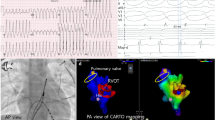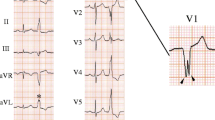Summary
Supraventricular tachycardias, as well as ventricular tachycardia, are critical in patients with hypertrophic cardiomyopathy. Anti-arrhythmic agents often induce arrhythmias, known as pro arrhythmia. Radiofrequency catheter ablation has become a well-established therapy for the treatment of supraventricular tachycardia. The reported success rate is over 90%, although catheter mapping in the left ventricle is difficult in patients with hypertrophic cardiomyopathy because of the marked left ventricular wall thickening associated with bizarre myocardial hypertrophy with disorganization, the abundant capillary muscle networks, and annoying ventricular arrhythmias. This report documents catheter mapping technique of radio frequency ablation in patients with hypertrophic cardiomyopathy and supraventricular tachycardias.
Similar content being viewed by others
References
Sekiguchi M, Hongo M, Morimoto S, et al. Long-term prognosis and treatment of hypertrophic cardiomyopathy. In: Sekiguchi M, Richardson PJ, eds. Cardiomyopathy Update 5. Tokyo: University of Tokyo Press, 1994:41–59.
Frank MJ, Watkins LO, Prisant LM, Stefadouros MA, Abdulla AM. Potentially lethal arrhythmias and their management in hypertrophic cardiomyopathy. Am J Cardiol 1984;53:1680–1613.
Kinoshita O, Nakatsuka T, Sekiguchi M, et al. Treatment of hypertrophic cardiomyopathy with a third-generation implantable cardioverter-defibrillator. In: Sekiguchi M, Richardson PJ, eds. Cardiomyopathy Update 5. Tokyo: University of Tokyo Press, 1994:41–59.
Touboul P, Kirkorian G, Atallah G, Cahen P, Zuloaga C, Moleur P. Atrioventricular block and preexcitation in hypertrophic cardiomyopathy. Am J Cardiol 1984;53:961–963.
Krikler DM, Davies MJ, Rowland E, Goodwin JF, Evans RC, Shaw DB. Sudden death in hypertrophic cardiomyopathy: Associated accessory atrioventricular pathways. Br Heart J 1980;43:245–251.
Scheinman MM, Morady F, Hess DS, et al. Catheter-induced ablation of the atrioventricular junction to control refractory supraventricular arrhythmias. JAMA 1982;248: 851–855.
Morady F, Scheinman MM. Transvenous catheter ablation of a posteroseptal accessory pathway in a patient with the Wolff-Parkinson-White syndrome. N Engl J Med 1984;310: 705–707.
Jackman WM, Wang W, Friday KJ, et al. Catheter ablation of accessory atrioventricular pathways (Wolff-Parkinson-White syndrome) by radio frequency current. N Engl J Med 1991;324:1605–1611.
Haissaguerre M, Gaita F, Fischer B, et al. Elimination of atrioventricular nodal reentrant tachycardia using discrete slow potentials to guide application of radio frequency energy. Circulation 1992;85:2162–2175.
Zipes DP, DiMarco JP, Gillette PC, et al. ACC/AHA guidelines for clinical intracardiac electrophysiological and catheter ablation procedures. Circulation 1995;92:675–420.
Author information
Authors and Affiliations
Rights and permissions
About this article
Cite this article
Kinoshita, O., Sekiguchi, M., Isobe, M. et al. Radiofrequency catheter ablation of supraventricular tachycardias in patients with hypertrophic cardiomyopathy. Cardiovasc Drug Ther 10, 527–530 (1996). https://doi.org/10.1007/BF00050992
Received:
Accepted:
Issue Date:
DOI: https://doi.org/10.1007/BF00050992




